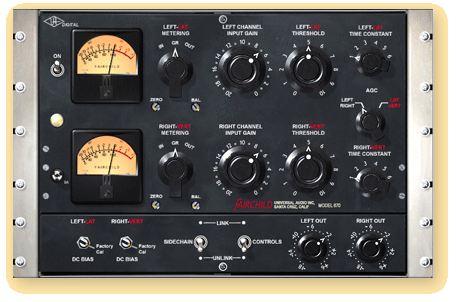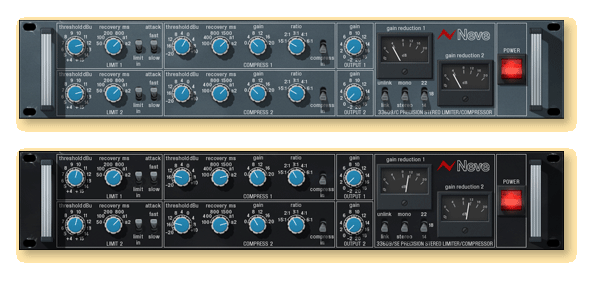Plug-In Power: The Fairchild 670 and Neve 33609
By Dave Crane
In this issue of "Plug-in Power," we're going to listen to two classic bus compressors in action, the Fairchild 670 and the Neve 33609.
 |
|
Figure 1: UAD Fairchild 670 Compressor
|
The Fairchild 670 was one of the first bus compressors; it debuted in the early 1950s. It was connected right before a cutting lathe used to create vinyl record masters (remember records?). The compression prevented the cutting tool from cutting the grooves too deep (amplitude) or too wide (frequency). Variable-mu limiters, like the Fairchild 670, are unique in that they use tubes, not just amplifiers, for gain reduction. The audio path is quite simple, and compression happens directly in the audio path rather than on a separate compression circuit.
 |
|
Figure 2: UAD Neve 33609 and 33609SE compressors
|
UA's engineers made a perfect digital replica of the 670 based on a "golden unit" at Ocean Way Studios in L.A. But we added a few features that are not found on the original unit, and the most useful of these are the output gain controls. These output gain controls allow you to level-match your compressed signal to your uncompressed signal. In the video below, I am using the Fairchild on a drum bus to increase the overall apparent loudness and ambience of the drums without making them sound overly compressed.
The Neve 33609 stereo bus compressor/limiter utilizes a bridged-diode gain reduction circuit and many custom transformers to achieve its signature sound. It has been a studio standard since its release in 1985. UA modeled the 33609c, which came out a couple of years later. As with the Fairchild 670, we added a couple of new features not found in the original hardware, most notably a headroom switch and an output gain. The headroom switch allows the unit to behave just like its analog sibling on the 22 setting, and to integrate more easily into the relatively high-amplitude digital world with the 18 and 14 settings.
In the first video below, I use the 33609 similarly to the Fairchild 670: I am just trying to increase the overall apparent volume, but I don't want the compressed drums to peak any higher than the original drums.
In the second video, I am using the 33609 to add ambience and power to a drum track by using a common trick. I have a prefader send sending my drum mix to a bus track, and on that track, I have a 33609 that is compressing the heck out of the drums, giving the mix a highly ambient and "trashy" effect. Then I mix this drum track with the original to add as much or as little of the effect as I want. I could also add an EQ before or after the 33609 to refine the effect. Another trick is to automate this drum bus so that as the song progresses and gets more intense, you can turn up this compressed drum bus to add a more powerful effect on the drums.